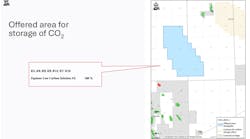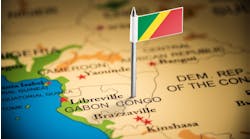Africa
In early August, Exxon Mobil Corp. subsidiary Esso Exploration Angola Ltd., started production of the $3.4-billion Kizomba A project, the largest deepwater development offshore West Africa. Recoverable resources are estimated at 1 Bbbl, with an expected production rate of 250,000 b/d.
"Kizomba A employs the world's largest FPSO, and the start-up of this project is an important milestone in Angola," Harry J. Longwell, director and executive vice president, ExxonMobil, says.
Kizomba A is the first of three world-class production developments on block 15 that are intended to collectively develop over 2.5 Bbbl of oil at a total investment of around $10 billion. Located 230 mi northwest of Luanda, Kizomba A will develop the Hungo and Chocalho discoveries in water depths of 3,300-4,200 ft. The development includes a surface wellhead platform and subsea wells tied back to the FPSO, which has a storage capacity of 2.2 MMbbl.
In November 2003, ExxonMobil announced first oil production on block 15 from the Xikomb A project, which employs an early production system (EPS) to produce 90,000 b/d. Xikomba is one of three identical EPS systems now deployed by ExxonMobil affiliates in West Africa.
ExxonMobil and its co-venturers have announced 38 discoveries off Angola, 17 of which are on block 15, with the potential to recover about 4.5 Bboe.
While Kizomba A begins production, state-owned Sociedade Nacional de Combustíveis de Angola (Sonangol) has authorized Total, as block 17 operator, to award the main contracts to initiate development of the Rosa oil field. Discovered in 1998, Rosa is located 135 km offshore in 1,300-1,500 m of water.
Rosa will be developed with 25 subsea wells – 14 producers and 11 injectors – tied back to the Girassol FPSO, anchored 15 km away. Modifications to the FPSO will increase the yearly average production rate to 250,000 b/d.
Sonangol is the block 17 concessionaire. Total Angola has a 40% participatory interest in the block, alongside Esso Exploration Angola Ltd. with 20% interest, BP Exploration Ltd. with 16.67%, Statoil Angola AS with 3.33% interest, and Norsk Hydro with 10% interest.
Norsk Hydro ASA is buying a 30% stake in the Majunga block offshore Madagascar.
The block covers 17,800 sq km in the relatively unexplored deepwater.
The Majunga Offshore Profond joint venture group is conducting a comprehensive 3D seismic acquisition program covering 3,657 sq km of the deepwater portion of the block. The survey will further evaluate the hydrocarbon potential of the Majunga salt basin. The current 3D program is designed to identify and evaluate potential drilling locations for an exploratory drilling program.
PGS's M/V Ramform Challenger is acquiring the data. The acquisition program, which began in late July, represents the first 3D seismic ever acquired in East Africa.
According to Hydro, potential drilling on the block will take place in 2006 at the earliest.
Vanco Madagascar Ltd. operates the block with a 30% stake, ExxonMobil has 40%, and Hydro has 30% interest.
Americas
Colombia's Ecopetrol, Petrobras, and Exxon Mobil Corp. affiliate, ExxonMobil Exploration Colombia Ltd., have signed the first exploration and production contract with Colombia's national hydrocarbon agency to begin exploration activities offshore.
The agreement covers the 11-million-acre Tayrona block, off Colombia's northern coast in the Caribbean Sea.
Initial work in the first 18-month phase of the exploratory program includes acquiring 3D seismic data acquisition and reprocessing existing 2D data.
ExxonMobil also plans to use its remote reservoir resistivity mapping technology, a proprietary electromagnetic survey technique that has been used in other offshore areas.
ExxonMobil and Petrobas each hold 40% interest in the block. Colombia's Ecopetrol holds 20%.
Mediterranean
The Egyptian Ministry of Petroleum's Egyptian Natural Gas Holding Co. will hold an international bid round this year. Nine blocks will be on offer, seven in the Mediterranean Sea. The blocks, N. Ras El Hekma, N. Sidi Kerir Deep, N. El Amyria, El Bougaz, N. El Bougaz, North El Temsah Deep, and N. Sinai Deep lie in areas north of the Western Desert to northeast of the Nile Delta.
Data packages were available as of Sept. 1. Bids close Dec. 1.
null
Libya is also gearing up for a bidding round, the first since the US lifted sanctions. Blocks will be offered in an open bid process that will close in January 2005, with awards made the same month. Awards will reportedly be made under new terms that are designed to be more attractive to bidders.
Both onshore and offshore blocks are on offer.
Europe
Some potentially interesting areas are coming up for bid in Europe in the coming months.
The Faeroe Islands will hold its second licensing round in the spring. The area offered for licensing lies east and south of the Faeroe Islands and covers 19,000 sq km, divided into 83 whole blocks and 39 part-blocks.
The Ministry of Trade and Industry says the objective of this licensing round is to continue the exploration activities that began under the first licensing round to establish the existence of commercially exploitable hydrocarbon reserves.
According to Minister of Trade and Industry Bjarni Djurholm, "We want to draw attention to the many opportunities still unexplored and in particular, the chances of discovering substantial hydrocarbon accumulations in the Faeroese area."
Applications are due at the Faroese Petroleum Administration by Nov. 17. Licenses are to be awarded next January.
Blocks are also going to be available in the Baltic Sea. The Natural Resources Ministry and the government of Kaliningrad region are working on a list of license blocks. The blocks include Shelf-1 and Shelf-2 on the Baltic Sea shelf and Kurshky Bay. Onshore blocks will also be part of the offering.
Toreador Resources Corp. and its partners Stratic Energy Corp. and TPAO, the Turkish national oil company, discovered gas with the Ayazli-1 exploratory well in the western Black Sea offshore Turkey.
The Ayazli-1 well, spudded July 12, is on the shallow-water South Akcakoca prospect five miles offshore. The well will be temporarily suspended pending future development activity in the South Akcakoca area. Toreador plans to conduct a high-definition seismic survey in 4Q 2004 and drill several appraisal and exploratory wells in 2005 while finalizing plans for development infrastructure in the area.
Toreador operates the well through its subsidiary Madison Oil Turkey Inc. and is responsible for 75% of the Ayazli-1 costs, retaining 36.75% working interest. Stratic Energy Corp. is funding 25% of the costs of the well to earn a 12.25% interest in eight adjacent permits that comprise 962,000 acres. TPAO is being carried on the well for a 51% working interest.
Asia-Pacific
India's Reliance Industries Ltd. still has the Midas touch. The company recently reported a major gas discovery in the D-6 block and a second gas discovery in the NEC-25 block off India's east coast.
The deepwater M-1 exploration discovery well in the D-6 block was drilled in 1,327-m water depth to 2,942 m. Reliance estimates that M-1 has 155 m of net pay, making it one of the thickest net pay gas sections encountered to date in the block.
M-1 is the 11th consecutive successful well drilled in the 1.9-million-acre block. All drilling to date has been based on the first 1,800-sq-km 3D seismic program that covers less than 20% of the block. An additional 2,500-sq-km 3D program is being processed and merged with the original survey.
In block NEC 25, the A2 well, drilled in 70 m of water, tested at rates up to 15.8 MMcf/d. This is the fourth consecutive gas discovery in NEC-25. Plans are progressing for fast-track gas production.
Central Asia
Kazakhstan is positioning itself to pick up some of the slack in global oil production. According to Uzakbay Karabalin, president of Kazakhstan's state oil company, KazMu-naiGas, Kazakhstan expects to produce 1.2-1.3 Bbbl of oil per year by 2015. Most of the growth will come from the TengizChevroil LLP, Karachaganak, and North Caspian projects. Last year, Kazakhstan produced 396 MMbbl of oil.
According to KazMuniGas, the most challenging and most promising project the world petroleum industry has recently faced is the Kashagan field in the Caspian Sea. Kashagan has total geological reserves of 38.4 Bbbl of oil, with recoverable reserves of 13 Bbbl.
"The Kashagan field alone can hold roughly the same amount of oil as Brazil, which is South America's largest oil producer," Karabalin says.
Output of the first stage of development is already under way and is expected to reach 75,000 b/d by 2008, with significant potential for further development to up to 450,000 b/d. "We believe that oil from the Caspian Sea will be the newest source to help to stabilize oil prices around the world," he says.
Agip KCO Consortium is exploring and developing the Kashagan field along with smaller, but important, oil fields including Kairan, Kalamkas, Kashagan South-West, and Aktote.
Middle East
Egypt's Ministry of Petroleum has reportedly signed two agreements with BP PLC regarding the Gulf of Suez. One is for exploration in the Northern Shedwan area, where BP will spend at least $20 million on four wells over a nine-year period.
The second agreement amends the gas pricing system connected to BP's offshore concession of East Tanka.
Australia activity
The Australian government's award of four new offshore petroleum exploration permits off Western Australia and Ashmore and Cartier Islands will generate over $87 million in exploration activities over the next six years. The blocks were awarded in June and July, and considerable seismic programs are being planned. Nominations closed for the 2005 bidding round at the end of July.
Australia's offshore has been particularly busy of late.
BHP Billiton's Pyrenees development in the Exmouth sub-basin 45 km off the coast of Western Australia is about to take off. The company has drilled six wells since May in water depths from 190 m to 210 m.
Mike Weill, BHP president Americas/Australia operations and technology, says the Stickle-1, Harrison-1, Crosby-2, and Ravensworth-2 results represent a series of oil discoveries over adjacent fault terraces.
"These accumulations occur in reservoirs of similar size and quality and are relatively close to one another. We can develop these as a combined scheme, and together they equate to a medium-sized oil reserve," Weill says.
BHP's oil discovery off Western Australia was followed by ChevronTexaco Corp.'s gas discovery. Wheatstone-1, 110 mi west-northwest of Dampier, underwent a production test that established a flow rate of 54 MMcf/d, constrained by rig equipment.
Western Australia has also caught the attention of India's ONGC Videsh Ltd., which has reportedly reached an agreement with Antrim Energy Inc., Canada, to acquire majority interest in exploratory block WA 306 P. The block, which covers 4,600 sq km, contains a cluster of drilling prospects in the Barcoo sub-basin. This investment marks OVL's entry into the Australian oil and gas industry.
The acquisition will become final pending approval by the Australian Government.
As OVL gets its feet wet, Santos is expanding its Australian holdings offshore Victoria with the decision to increase to 50% its equity interests in both the Patricia Baleen and the Sole gas fields.
Santos will obtain an additional 30% interest from Trinity Gas Resources Pty. Ltd. in the Patricia Baleen gas field and associated processing facilities in eastern Victoria and an additional 15% interest in the Sole gas field.
Santos contracted Diamond Offshore's Ocean Bounty semisubmersible to drill the horizontal Baleen 4 production well, which was to spud in September.
Tap Oil Ltd. is also increasing its holdings off Australia with an agreement with OMV Australia Pty. Ltd. to farm in to three exploration permits that surround Tap's production license over the Woollybutt oil field in the Otway basin. Tap will acquire 25% interests in each of permits WA-290-P, WA-320-P, and WA-345-P.
The WA-290-P permit is covered by 3D seismic data. Two wells are planned for early 2005 at Lauda-1 and Maier-1, 21 km and 14 km northwest of the producing Woollybutt field.




